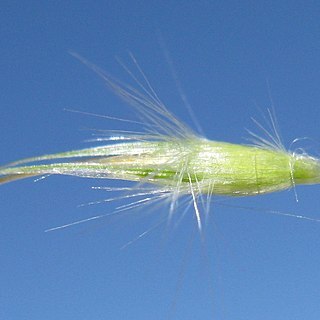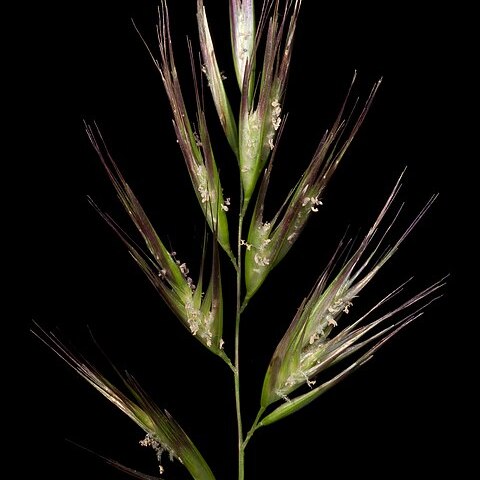Strict, crowded tufts with erect leaves and culms, occasionally shortly rhizomatous; leaves semi-pungent, ≤ culms; branching intravaginal. Leaf-sheath whitish cream, glabrous, or few to many hairs usually near collar; apical tuft of hairs 2-3.5 mm. Ligule 0.3-0.5 mm. Leaf-blade to 17 cm, dull green, narrowly inrolled, or flatter, scattered to dense, short, stiff hairs, sometimes glabrous, margins closely scabrid. Culm to 45-(65) cm, internodes glabrous but with a few short hairs just below inflorescence. Panicles erect, to 5-(10) cm, compact, few, large spikelets on short pedicels; rachis and pedicels closely short-scabrid, often with stiff longer hairs at branch axils and below spikelets. Spikelets 4-9-flowered, awns much exserted from glumes. Glumes green, purple-tinged, lanceolate, subacute, ± equal, 11-15-(19) mm, both 5-7-nerved, occasionally a few long hairs or densely hairy. Lemma 2.7-4 mm, 9-nerved, with two, rarely sparse to usually continuous, often dense rows of hairs, upper row < lemma lobes, lower row usually reaching base of upper, occasionally almost overlapping, usually glabrous elsewhere, occasionally a few short scattered hairs centrally and on margins, adaxially usually few longer hairs close to base of awn sinus; lobes (6.5)-7-10-(11) mm, tapering to long awns; central awn 10.5-20 mm, column (3)-4-5 mm usually » upper lemma hairs. Palea (3.2)-5-6 mm, narrow-lanceolate, < upper lemma hairs, occasional interkeel hairs, margins usually with long fine hairs. Callus (0.6)-1-1.4 mm, very dense marginal hair tufts often reaching to base of lower lemma hairs. Rachilla 0.1-0.2-(0.4) mm. Anthers 0.3-0.6 and 0.7-2 mm. Caryopsis c. 2 × 1 mm; embryo c. 1 mm; hilum c. 0.7 mm.
More
Plants caespitose; innovation buds intravaginal. Culms 13–90 cm high. Leaf blades thin, flexuose. Inflorescences linear-lanceolate to triangular; branches villous or scaberulous. Spikelets 12.5–22 mm long, with 6–9 florets. Glumes slightly exceeding florets, pale green, usually with purple margins; lower glume 12.5–23 mm long, 3.5–4 mm wide. Lemma: body 2–3.5 mm long, glabrous or villous between the rows of tufts; upper row of hair tufts complete; lower row of tufts complete or often with middle 2 tufts missing, rarely several of the central tufts reduced, usually not reaching (sometimes equalling) upper row; lobes longer than body, but not twice as long; setae 2.5–8 mm long, curved out like horns, shorter than to longer than lobes; awn 8.8–20.6 mm long, exceeding setae; awn column tightly twisted, exceeding (or rarely equalling) lobes but shorter than setae. Palea linear to lorate, 3.3–6 mm long, narrow, 3–5 times as long as wide, exceeding (rarely not quite reaching) lemma sinus. Anthers 0.2–0.8 mm long. Caryopsis 1.2–2 mm long.


